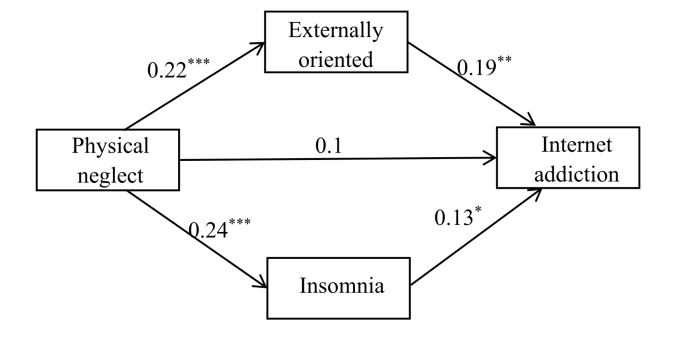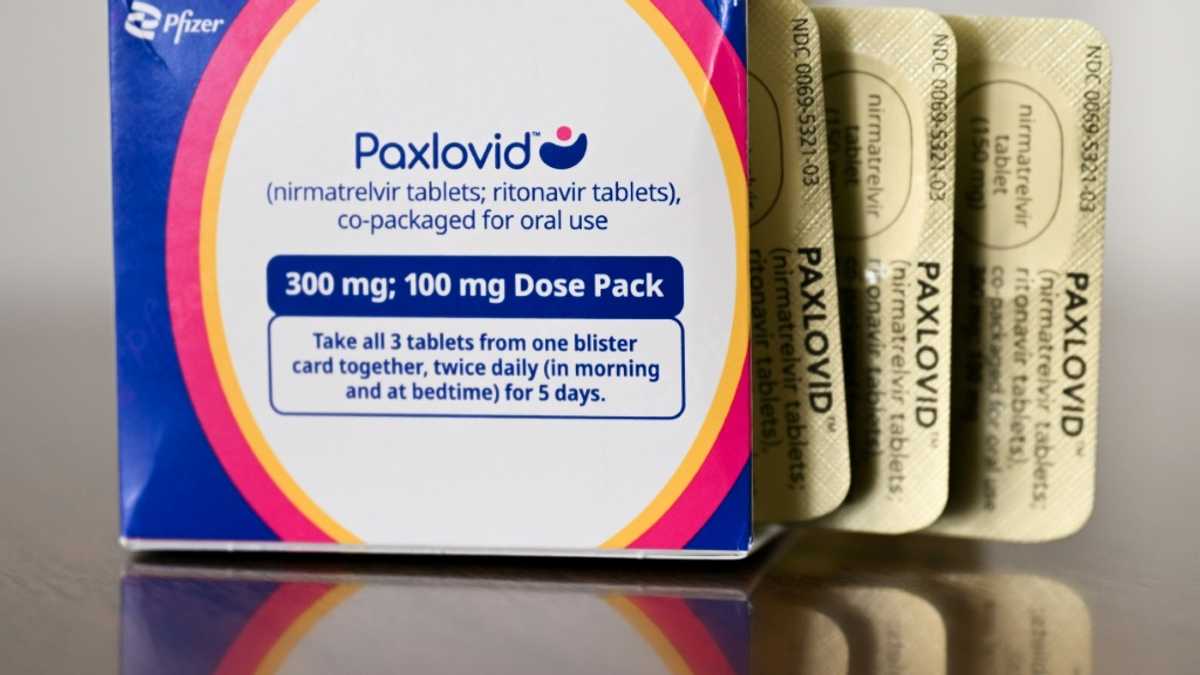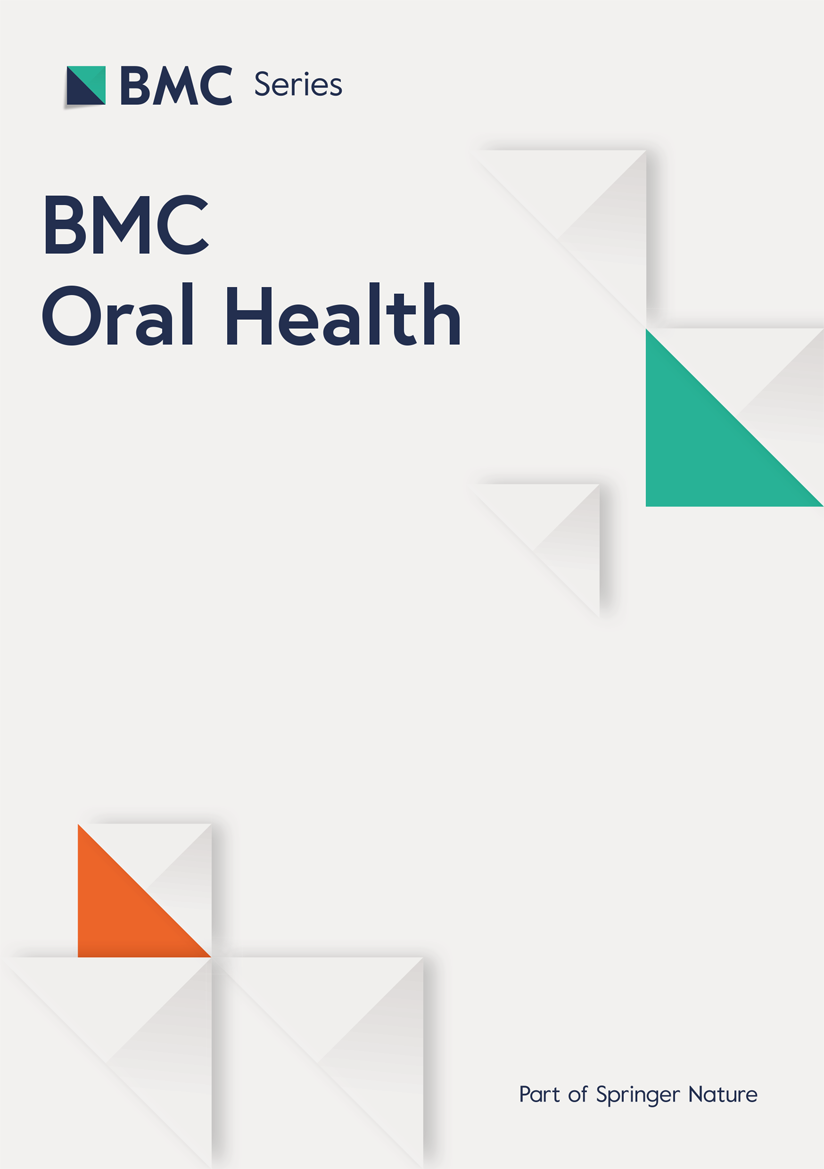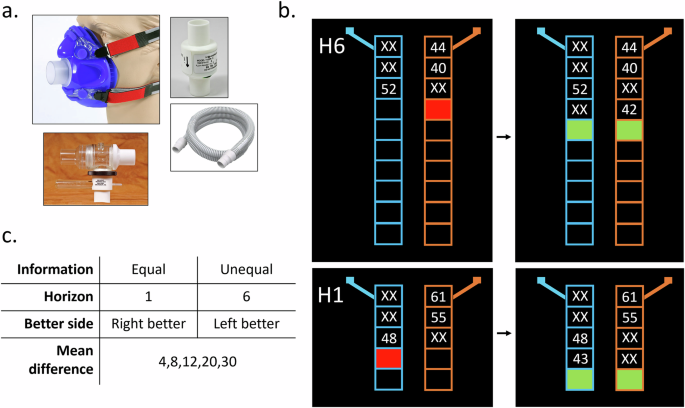BMC Psychiatry volume 25, Article number: 298 (2025) Cite this article
The correlation between depressive symptoms and internet addiction in adolescents is strengthened, and childhood trauma is an important predictor of internet addiction. However, the mechanism of childhood trauma on internet addiction in adolescents with depression remains unclear. This study investigates the current status and factors influencing internet addiction in adolescents with depression and further examines whether insomnia and alexithymia mediate childhood trauma and internet addiction in adolescents with depression.
This study investigated 300 adolescent patients in 7 hospitals in Anhui province. General demographic characteristics such as age and gender were collected. The clinical characteristics of the patients were measured using the Childhood Trauma Questionnaire Short Form (CTQ-SF), Internet Addiction Test (IAT), Insomnia Severity Index (ISI) and 20-item Toronto Alexithymia Scale (TAS-20). PROCESS (Model 4) was used to examine the mediating effects of insomnia and alexithymia.
The prevalence of internet addiction among adolescents with depression was 50.2%. There were statistically significant differences between the internet addiction group and the non-internet addiction group in terms of relationships with classmates, relationships with teachers, family relations, and economic status. The total score of CTQ and its five subscale scores were significantly and positively correlated with the total score of IAT. Insomnia and externally oriented thinking (EOT) played a significant mediating role in the effect of physical neglect (PN) on internet addiction.
Insomnia and alexithymia play a significant mediating role between childhood trauma and internet addiction in adolescents with depression, which expand the existing understanding of internet addiction in adolescents with depression, and provide some theoretical references to address the problem of internet addiction in adolescents with depression and prevent the development of adolescent depression.
Depression is a major public health problem. Approximately 280 million people in the world suffer from depression, and more than 700,000 people die by suicide each year [1]. Depression usually begins in adolescence and is the leading cause of disability and suicide in adolescents [2]. According to the National Blue Book of depression in 2022, the incidence of depression among Chinese adolescents is 15–20%, and is on the rise year by year. The suicide risk of adolescents with major depression is 30 times higher than that of normal people [3]. The high incidence of morbidity, high mortality and serious harm of depression among adolescents have brought great negative impact on adolescents themselves, their families and society, which should be paid great attention to [4].
Internet use is gaining popularity among adolescents. As of June 2024, there were nearly 1.1 billion internet users in China, an increase of 7.42 million compared with December 2023, of which adolescents accounted for 49.0% [5]. Excessive and pathological use of the internet can cause internet addiction. Currently, the global prevalence rate of internet addiction is 7.02%, with the age of onset of internet addiction gradually decreasing and the prevalence gradually increasing [6]. The incidence of internet addiction among Chinese adolescents is as high as 10% [7]. Internet addiction in adolescents is associated with a range of negative health outcomes, including mental health problems (such as depression), interpersonal difficulties, decreased academic performance, and social isolation [8,9,10]. Among these, depression usually accompanies internet addiction and is a significant factor that increases the risk of internet addiction [11]. According to a study, the prevalence rate of comorbid internet addiction in patients with depression is as high as 58.6% [12]. Adolescents suffering from internet addiction are more likely to develop depression, and internet addiction is strongly associated with non-suicidal self-injury and suicide [13, 14]. In view of their relationship and frequent co-occurrence, it is crucial to explore the influencing factors and underlying mechanisms of internet addiction in adolescents with depression.
Childhood trauma usually refers to severe adverse childhood experiences, mainly including abuse and neglect. According to a meta-analysis, nearly 57% of people experienced childhood trauma before the age of 18 [15], and the prevalence of childhood trauma among Chinese adolescents was as high as 79.01% [16]. Childhood trauma is a major risk factor for psychosocial dysfunction, including mood disorders, depression and internet addiction [17, 18]. Childhood trauma contributes to the development of adolescent depression, and depressed patients with childhood traumatic experiences are more likely to be characterized by early onset, recurrence, severe symptoms, long duration, and poor prognosis [19]. In addition, childhood trauma is a major predictor of internet addiction. It increases susceptibility to internet addiction by disrupting the neural structure and functioning of the brain and stress response systems [20, 21], which in turn causes adverse health outcomes and behavioral problems in adolescents. Gender differences may affect the relationship between childhood trauma and internet addiction. Female adolescents are more likely to have emotional problems after abuse, while males are more likely to have behavioral problems [22]. Therefore, it is important to explore the mechanisms linking childhood trauma and internet addiction for the prevention and intervention of depression in adolescents.
Insomnia may play an important role between childhood trauma and internet addiction, and childhood trauma may influence the incidence of internet addiction through insomnia. Many countries have reported a high prevalence of insomnia in adolescents, and adolescent sleep problems have become commonplace [23]. Adolescence is a critical period for the formation of healthy sleep patterns. Insomnia during this period can lead to a range of adverse physical and mental health outcomes, such as reduced learning ability, interpersonal difficulties, suicidal behavior, and internet addiction [24,25,26]. A retrospective study showed that insomnia increased the risk of suicide by 1.95–2.95 times [27]. Childhood trauma may increase the risk of insomnia in adolescents and is negatively associated with sleep quality [28]. Sleep quality is significantly and negatively associated with internet addiction in adolescents, and adolescents with insomnia may expose the time needed for sleep to physical stimuli and light more often [29]. Therefore, it is worth studying whether insomnia has a significant effect on childhood trauma and internet addiction in adolescents with depression.
Alexithymia may be another influential factor in internet addiction caused by childhood trauma. Alexithymia is mainly characterized by difficulties in recognizing, distinguishing and expressing emotions [30]. It is a common psychosomatic phenomenon, which brings a series of problems to the healthy growth of adolescents. The prevalence of alexithymia is 10% in the general population [31] and 36% in the adolescent population [32]. The prevalence of alexithymia is higher in patients with psychiatric disorders, with depression being the most prominent [33]. Childhood trauma may be a major risk factor for alexithymia. Alexithymia is a cumulative process that begins in early childhood, continues to develop and strengthen in the social environment [34]. It is related to negative life events such as childhood, family environment, interpersonal relationship and social support [35, 36]. Among them, childhood trauma is considered to be the main risk factor of alexithymia, which hinders the ability to identify and express emotions, thus increasing the psychological distress of adolescents, and is closely associated with the occurrence and development of psychotic symptoms [37]. In addition, alexithymia has been suggested to be a predictor of internet addiction, which may increase the susceptibility of adolescents to internet addiction through deficits in cognitive processing and emotional regulation [38, 39], and proved to be a significant positive predictor of internet addiction. However, it is unclear whether alexithymia mediates between childhood trauma and internet addiction in adolescents with depression.
Previous studies have reported individual relationships between childhood trauma, depression, internet addiction, insomnia, and alexithymia, and most of the study populations were adolescents or adults. There is a gap in research on the mechanisms underlying the association between childhood trauma and internet addiction in adolescents with depression, and it is unclear whether insomnia and alexithymia play a role in it. Therefore, the purpose of this study was to explore the potential mechanisms of insomnia and alexithymia in childhood trauma and internet addiction in adolescents with depression, and to provide some theoretical references for the clinical diagnosis, treatment and prevention of adolescent depression.
From January to July 2021, 257 adolescent depression patients (193 females), with an average age of 15.22 ± 1.70 years, were enrolled in psychiatric outpatients and inpatients in four psychiatric hospitals and three general hospitals in Anhui Province. Inclusion criteria: (1) assessed by two psychiatrists in a structured clinical interview, met the diagnostic criteria for depression in the Diagnostic and Statistical Manual of Mental Disorders 5th Edition (DSM-5); (2) aged 12–18 years old with a certain degree of comprehension; (3) informed consent was obtained from the participants and their legal guardians and signed an informed consent form. Exclusion criteria: (1) diagnosis of bipolar disorder, schizophrenia, or other mental disorders; (2) serious physical disease or uncooperative individuals. Initially, a total of 300 questionnaires were collected, and 43 unqualified questionnaires were excluded, of which 11 were incomplete and 32 did not meet the inclusion criteria. The study was approved by the Medical Ethics Committee of Chaohu Hospital Affiliated to Anhui Medical University (2009-kyxm-04). All questionnaires were archived and the findings were kept strictly confidential.
General demographic characteristics
This study collected general demographic data of the participants, such as age, gender, only child (yes or no), left-behind children (yes or no), study pressure (little, average, big), relationship with classmates (good, average, bad), relationship with teachers (good, average, bad), marital status of parents (normal, separation/divorce/remarriage, single/both deaths), family relations (good, average, bad), and economic status (rich, middle, poor).
Childhood trauma questionnaire short form (CTQ-SF)
The CTQ-SF consists of 28 items, including 25 clinical items and 3 validity evaluation items. Each item is rated on a 5-point Likert scale, from 1 (never) to 5 (always). The questionnaire contains five subscales: emotional abuse (EA), physical abuse (PA), sexual abuse (SA), emotional neglect (EN), and physical neglect (PN). Each subscale consists of five clinical items, and the sum of the five subscale scores yields a total scale score. The higher the total scores, the more severe the childhood trauma is [40]. The Chinese version of this scale is widely used among adolescents and has good reliability and validity [41, 42]. The Cronbach ‘s α coefficient of this study was 0.62.
Internet addiction test (IAT)
The IAT consists of 20 questions, using a 5-point Likert score ranging from 1 (almost never) to 5 (always), with an overall score ranging from 20 to 100. Higher scores indicate more severe internet addiction. In this study, the total score of IAT ≥ 50 was used as the criterion for determining internet addiction [43, 44]. The Chinese version has good reliability and validity [45, 46]. Cronbach’s α coefficient of this study was 0.92.
Insomnia severity index (ISI)
The ISI is a self-rating scale used to assess symptoms of insomnia in the last two weeks. It consists of seven items on a 5-point Likert scale ranging from 0 (none) to 4 (very severe), with a total score of 0–28. Higher scores indicate more severe insomnia symptoms. In this study, the total score of ISI ≥ 8 was used as the criterion for the determination of insomnia, among which 8–14 points were mild insomnia, 15–21 points were moderate insomnia, and ≥ 22 points were severe insomnia. Its Chinese version has good reliability and validity [47]. The Cronbach ‘s α coefficient of this study was 0.81.
20-item Toronto alexithymia scale (TAS-20)
The TAS-20 consists of three factors: difficulty identifying feelings (DIF), difficulty describing feelings (DDF) and externally oriented thinking (EOT). It consists of 20 entries scored on a 5-point Likert scale from 1 (completely disagree) to 5 (completely agree), with a total score between 20 and 100. Higher scores indicate more severe alexithymia. In this study, the total score of TAS-20 ≥ 61 was used as the criterion for the determination of alexithymia. Its Chinese version is widely used among Chinese subjects and has good reliability and validity [48,49,50,51]. The Cronbach ‘s α coefficient of this study was 0.76.
In this study, SPSS27.0 software was used to establish a database for analysis. Numerical variables are reported as the mean and standard deviation, and categorical variables are reported as the frequency and proportion. All data were tested for normality using the Kolmogorov-Smirnov test, and the results did not obey normality. Mann-Whitney U test (numerical variables and rank data) and Chi-square test (bitaxonomic variables and disordered multitaxonomic variables) were used to compare the differences in general demographic and clinical characteristics between the internet addiction group and the non-internet addiction group of adolescents with depression. Spearman correlation was used to analyze the correlation among all variables. A mediation model was constructed using PROCESS 4.1 (Model 4) to analyze the mediating effects of insomnia and alexithymia between childhood trauma and internet addiction in adolescents with depression. The mediating effect was tested using the Bootstrap method (sampling 5000 times across 95% confidence intervals). The indirect effect, which is the result of the mediation effect test, is considered significant if its Bootstrap 95% CI does not include 0. The total effect of childhood trauma on internet addiction is equal to the sum of indirect and direct effects. The parallel mediation model can represent the size of the mediation effect by the coefficient and significance of C1. If its Bootstrap95% CI includes 0, it indicates that there is no significant difference in the size of the mediation effect. The two-tail test was used for all hypotheses, and the significance level was 0.05.
A total of 300 questionnaires were collected and 257 were valid, with an effective recovery rate of 85.67%. As shown in Table 1, the average age of the participants was 15.22 ± 1.70 (ranging from 12 to 18 years old), including 64 males (24.9%) and 193 females (75.1%). The prevalence of internet addiction was 50.2%. There were no differences in age, gender, only child, left-behind children, study pressure and parental marital status between the internet addiction group and the non-internet addiction group (P > 0.05). There were significant differences between the internet addiction group and the non-addiction group in relationships with classmates, relationships with teachers, family relations and economic status (p < 0.05).
As can be seen from Table 2, the average CTQ score of the participants was 51.78 ± 12.77. The CTQ total score, EA score, PA score, SA score and PN score of the internet addiction group were significantly higher than those of the non-internet addiction group (p < 0.05), and there was no difference in EN score between the two groups (p = 0.05). The average ISI score of the participants was 13.44 ± 5.64, indicating that the participants as a whole were in a state of mild insomnia, and the total ISI score of the internet addiction group was significantly higher than that of the non-internet addiction group (p < 0.05). In addition, the average TAS score of the participants was 68.16 ± 8.95, indicating that the participants had alexithymia as a whole. The total TAS and EOT scores in internet addiction group were significantly higher than those in the non-internet addiction group (p < 0.05), but there was no difference in DIF and DDF scores between the two groups (p > 0.05).
As shown in Table 3, the total score of CTQ and its five subscales were positively correlated with the total score of IAT, with the strongest correlation between the IAT total score and SA and EA (r = 0.27, p < 0.01; r = 0.23, p < 0.01). The CTQ total score, EA score, PA score, SA score, and PN score were positively correlated with the total score of ISI, and the ISI total score also showed a significantly correlation with the IAT total score. In addition, the CTQ total score was positively correlated with the TAS total score, DIF score and EOT score. The EA score, EN score and PN score were significantly correlated with the EOT score, and the EOT score was also significantly and positively correlated with the total IAT score. Notably, the EOT score was not correlated with the ISI total score. Therefore, the mediation effect can be further analyzed.
In this study, PROCESS4.1 (Model 4) was used to construct seven models by controlling gender and age variables to determine the influence of childhood trauma on internet addiction through insomnia or alexithymia, and Bootstrap method was used to test the mediating effects. The results are shown in Table 4. PN had significant direct and indirect effects on internet addiction through insomnia. EA, EN and PN also had significant direct and indirect effects on internet addiction through EOT. Therefore, both insomnia and EOT played direct and indirect roles between PN and internet addiction, and there was no correlation between insomnia and EOT, which led to a parallel mediation model.
As shown in Table 5, the total effect of PN on internet addiction was significant (95% CI [0.24, 1.53], P < 0.01), and the total indirect effect of PN on internet addiction through insomnia and EOT was significant (Bootstrap95% CI [0.03, 0.13], P < 0.05). However, the direct effect of PN on internet addiction was not significant (95% CI [-0.16, 1.17], P > 0.05), and the Bootstrap95% CI for C1 included 0. Therefore, insomnia and EOT played a completely mediating role in the influence of PN on internet addiction, and the magnitude of the mediating effects of the two was not significantly different. In summary, a parallel mediation model between childhood trauma, insomnia, alexithymia, and internet addiction is drawn in Fig. 1.
A parallel mediation model between childhood trauma, insomnia, alexithymia and internet addiction. *: p < 0.05, **: p < 0.01, ***: p < 0.001
For the first time, this study explored the association mechanism between childhood trauma and internet addiction in the population of adolescents with depression, and found that insomnia and alexithymia played a significant mediating role in it, providing new ideas and strategies to address the problem of internet addiction in adolescents with depression.
This study showed that 50.2% of adolescents with depression suffered from internet addiction, which was significantly higher than that of adolescents without depression (10.4%) [52]. According to domestic meta-analysis, the prevalence of internet addiction ranges from 11.3 to 30.1% [53, 54]. The high prevalence of internet addiction in adolescents with depression may be due to the following factors. First of all, most adolescents with depression lack social skills and family support, and they prefer to interact with others through online platforms to reduce loneliness and social isolation. Secondly, they often rest at home and don’t go to school, so they have more leisure time and less family supervision, which makes it easier for them to access and indulge in the internet. The use of the internet can help them escape from reality, reduce stress and adjust their depression. Adolescents with more severe depressive symptoms are more likely to have internet addiction. There is a significant correlation between depression and internet addiction, depression increases the risk of internet addiction and conversely internet addiction may increase the risk of depression [11]. The prevalence of comorbidity of internet addiction in depressed patients was nearly 58.6% [55], which is similar to our findings. In addition, studies have found that patients with depression and internet addiction are related to a short allele in the promoter region of the serotonin transporter gene (SS-5HTTLPR), and patients with these two diseases have similar genetic and personality characteristics [56].
Internet addiction is common among adolescents. Internet addiction in adolescents often stems from negative emotions such as negative self-concept, loneliness, and psychological and behavioral problems such as social anxiety and poor interpersonal relationships. The family economic status may affect the social circle of adolescents, making it difficult for them to integrate into the group and feel lonely and helpless. Adolescents with financial difficulties in their families may feel anxious for a long time because they are worried about their family financial situation, their studies and their future. During adolescence, they have limited ability to regulate their emotions and in turn use the Internet more to cope with their emotional problems [57]. However, internet addiction affects the brain development of adolescents, negatively affects their cognition and time use, and is associated with various negative outcomes, such as social dysfunction, frequent family conflicts and inability to complete school work, which ultimately lead to suicidal ideation, academic failure and significant social costs [58,59,60]. This is similar to the results of this study, in which the adolescent patients in the internet addiction group showed significant differences from those in the non-internet addiction group in terms of their relationships with classmates, teachers, and family, as well as their economic status. Therefore, families and schools should work together to build a diversified social support system for adolescents, which is of great significance for reducing internet addiction and improving depressive symptoms.
Childhood trauma is an important predictor of internet addiction. The results of this study showed that the total CTQ score of the internet addiction group of adolescent depression patients was significantly higher than that of non-internet addiction group, and all five forms of childhood trauma were positively correlated with internet addiction in adolescent patients. This is consistent with the results of previous studies. A meta-analysis involving 21,398 adolescents showed a significant positive association between childhood trauma and internet addiction [61]. Adolescents with childhood trauma are more likely to develop internet addiction. Studies have found that childhood trauma is associated with structural brain changes involving threat detection, emotion regulation, and reward processing, as well as increased use of maladaptive emotion regulation strategies [62, 63]. In addition, childhood trauma also impairs neuroplasticity and neurogenesis in brain circuits that regulate emotion and motivation, which are the biological basis for susceptibility to Internet addictive behaviors [64]. However, the risk of developing internet addiction varies according to the type of childhood trauma. Different types of childhood abuse significantly affect the relationship between childhood trauma and internet addiction [65]. EA is related to persistent errors and difficulties, and SA is associated with decreased performance in inhibitory control and verbal memory. PA is associated with decreased performance in auditory attention and visual motor integration, problem solving, abstraction, and planning [66]. Compared with PA, EA is more likely to have long-term impacts on emotional regulation and interpersonal skills, increasing the risk for negative emotional regulation and poor coping strategies that lead to internet addiction [65]. In this study, SA and EA showed the strongest correlation with internet addiction, which is similar to the results of a cross-sectional survey on Chinese adolescents and young adults [67]. Additionally, a Turkish study showed that EA may be a major predictor of increased risk for internet addiction among types of childhood trauma [68]. However, a 2016 study found that countries such as the Netherlands and the United Kingdom had the lowest estimates of abuse, and high-income countries had lower estimates of PN, which in turn affected the detection of their association with internet addiction [69]. EN and PN may be more common among Chinese adolescents [70]. SA and EA have the greatest impact on internet addiction in females, and female adolescents are more likely to have emotional problems after abuse, while males are more likely to have behavioral problems [22]. These differences in findings may be related to different ages, gender, educational backgrounds, cultural and economic differences, and different choices of measurement tools. Therefore, exploring the mechanisms of action of specific types of childhood trauma on internet addiction in adolescents with depression provides a theoretical basis for subsequent targeted interventions.
Alexithymia mediates the relationship between childhood trauma and internet addiction. Childhood trauma is a major risk factor for alexithymia. In this study, we found that EA, EN, and PN were positively correlated with alexithymia, while PA and SA were not. This result is similar to that of Kooiman et al. [71]. Alexithymia is a cumulative process that begins in early childhood and is influenced by factors such as life experiences, early traumatic experiences, and insecure attachments, and continues to develop and strengthen in the social environment [34], which in turn increases susceptibility to depression and addictive behaviors. Alexithymia was present in the whole group of adolescents with depression, which is consistent with the results of previous studies. Patients with depression often use emotional suppression strategies to protect themselves from pain, and have difficulty subjectively recognizing and describing emotions. The prevalence of their alexithymia is significantly higher than that of other mental disorders [72]. This study found that Alexithymia was a significant predictor of internet addiction, especially EOT. Alexithymia patients have defects in cognitive processing and emotional regulation, are prone to lack of internal emotional experience and rigid thinking patterns. They often adopt regulatory strategies of inhibition rather than reevaluation, regard certain thoughts and negative emotional experiences as reality, and tend to use attention resources and coping strategies to change “reality” [38]. EOT plays an important role in the inhibitory control of alexithymia [73]. It is characterized by a greater focus on specific external stimuli rather than internal emotional feelings, leading people to pay less attention to related stimuli such as depression. These characteristics seem to have a protective effect on individuals, but in the long run, this avoidance not only affects their interpersonal relationships, but also seriously affects the balance between their stress reinforcement and stress training processes, which in turn promotes the development of internet addiction.
Childhood trauma seriously affects the sleep of adolescents with depression, and it is one of the reasons for the high rate of insomnia and recurrence of depression in depressed patients. A cohort study confirmed the relationship between childhood trauma and insomnia [74]. On the one hand, childhood trauma may lead to insomnia through family dysfunction, lack of interpersonal relationship and social support, and the development of mental health disorders. With the increase of the number of traumatic events, insomnia also increase, and there is a hierarchical relationship between them [75]. On the other hand, childhood trauma can lead to sleep problems such as sleep fragmentation, reduced slow-wave sleep, and shorter sleep duration by activating the hypothalamic-pituitary-adrenal system, which makes catecholamines, cortisol, adrenocorticotropin and adrenocorticotropin releasing hormone hyperactive [76, 77]. This study found a significant correlation between insomnia and internet addiction, which is consistent with previous findings. A study of 1253 children and adolescents in Taiwan found a correlation between early and moderate insomnia and internet addiction [78]. Insomnia was more severe in the internet addiction group than in the non-internet addiction group of adolescents with depression. This is similar to a study by Kawabe et al., in which the internet addiction group had significantly shorter nighttime sleep duration compared to the non-internet addiction group [79]. The link between insomnia and internet addiction may be mediated through extensive abnormal connections in the hippocampus, and they may be an emotional response to childhood trauma [80]. This study found a significant mediating role of insomnia between childhood trauma and internet addiction. This was also confirmed by a study in a southern Chinese city, where sleep duration modulated the relationship between childhood trauma and internet addiction. Childhood trauma score was positively correlated with internet addiction and sleep duration, while sleep duration was negatively correlated with internet addiction [81].
The study has the following limitations. First, this study was a cross-sectional design, so the causal relationship between the variables cannot be determined, and it is meaningful to conduct longitudinal studies in the future. Second, the samples in this study were all from Anhui Province. Due to the differences in culture, education and economic level in different regions, the results may not be well generalized to China or other countries. Future research will expand the sample range to improve the universality of the results. Third, part of the data of this study collected by self-report may lead to recall bias, and our findings should be interpreted with caution. Fourthly, due to the limited variables included in the study, there may be other unmeasured variables that also mediate between childhood trauma and internet addiction, and the omission of these variables may affect the accurate estimation of the mediating effect. Finally, the sample size of this study was relatively small and consisted mostly of female patients, which may have had some impact on our results. The gender difference in this study may be influenced by the characteristics of depression in adolescents [82]. This study controlled for the potential effects of data such as age and gender in the model construction. However, the influence of gender on childhood trauma and internet addiction cannot be ignored [83]. Future studies should increase the sample size, enrich the research variables, balance gender, and focus on exploring the role of gender in childhood trauma and internet addiction among adolescents with depression.
In summary, this study found that insomnia and alexithymia play a significant mediating role between childhood trauma and internet addiction in adolescents with depression, expanding our existing understanding of internet addiction in adolescents with depression, and providing theoretical references to address the problem of internet addiction in adolescents with depression and preventing the development of depression.
The datasets used and analyzed in this study are available from the corresponding author on reasonable request.
- CTQ-SF:
-
Childhood Trauma Questionnaire Short Form
- IAT:
-
Internet Addiction Test
- ISI:
-
Insomnia Severity Index
- TAS-20:
-
20-item Toronto Alexithymia Scale
- EA:
-
Emotional abuse
- PA:
-
Physical abuse
- SA:
-
Sexual abuse
- EN:
-
Emotional neglect
- PN:
-
Physical neglect
- DIF:
-
Difficulty identifying feelings
- DDF:
-
Difficulty describing feelings
- EOT:
-
Externally oriented thinking
Thanks to Professor Bagby and Professor Yonggui Yuan for authorizing us to use the TAS-20, and to all the adolescent patients who participated in this study.
This study was supported by the Research Fund Project of Anhui Translational Research Institute (2022zhyx-B01).
This study was approved by the medical ethics committee of Chaohu Hospital affiliated to Anhui Medical University (202009-kyxm-04). All research procedures were strictly in line with the principles of the Helsinki Declaration. Written informed consent to participate in this study is provided by participants and their legal guardians.
Not Applicable.
The authors declare no competing interests.
The clinical trial registration of this study has been completed in January 2021 (ChiCTR2100041826).
Springer Nature remains neutral with regard to jurisdictional claims in published maps and institutional affiliations.
Open Access This article is licensed under a Creative Commons Attribution-NonCommercial-NoDerivatives 4.0 International License, which permits any non-commercial use, sharing, distribution and reproduction in any medium or format, as long as you give appropriate credit to the original author(s) and the source, provide a link to the Creative Commons licence, and indicate if you modified the licensed material. You do not have permission under this licence to share adapted material derived from this article or parts of it. The images or other third party material in this article are included in the article’s Creative Commons licence, unless indicated otherwise in a credit line to the material. If material is not included in the article’s Creative Commons licence and your intended use is not permitted by statutory regulation or exceeds the permitted use, you will need to obtain permission directly from the copyright holder. To view a copy of this licence, visit http://creativecommons.org/licenses/by-nc-nd/4.0/.
Wang, X., Sun, F., Geng, F. et al. The relationship between childhood trauma and internet addiction in adolescents with depression: the mediating role of insomnia and alexithymia. BMC Psychiatry 25, 298 (2025). https://doi.org/10.1186/s12888-025-06739-x
Received:
Accepted:
Published:
DOI: https://doi.org/10.1186/s12888-025-06739-x













